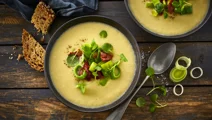
Goulash soup

Instructions
To serve
Choosing the best beef
Selecting the right beef cut is essential to unlocking the deep, rich flavour and texture that makes goulash special. Chuck is a top choice because its marbling ensures tenderness when cooked low and slow. For something different, choose beef cheeks, which bring distinctive textures, though they may require slightly longer cooking times. For leaner options, brisket will work, but the result will be firmer. Regardless of the cut, be sure to trim excess fat, as too much can make the broth greasy.
Get the perfect sear
To achieve the deep, bold flavour characteristic of goulash, getting a good sear on your beef is crucial. Sear the meat in batches, ensuring that each piece has enough room in the pan to caramelise properly, which prevents steaming. Start with a hot pan and just enough oil to coat the bottom, heating it to medium-high so that the meat can brown evenly. Flip the beef as each side turns golden brown, locking in the juices.
FAQ: Questions about goulash soup
If you are curious to know more about goulash soup, we have compiled some common questions to help you perfect the recipe. Learn more about this rich, flavourful soup by continuing to read below.
Goulash soup is a Hungarian staple known for its rich and aromatic broth with savoury ingredients. The traditional recipe combines slow-cooked beef, onions, and root vegetables, all simmered in a deeply seasoned broth infused with mild paprika. Unlike the thicker goulash stew, the soup version has a thinner broth, ideal for dipping crusty bread. While variations exist, the core elements remain the same: beef, potatoes, and a savoury broth steeped in the iconic paprika flavour that defines Hungarian cuisine.
Yes, you can make goulash ahead, and its flavours only improve with time. Once the soup has cooled, store it in the fridge for up to 3 days or the freezer for up to 3 months. If you want to make it in advance, think about the potatoes you use. They can soften after freezing, so consider using waxy varieties like Yukon Gold or red potatoes, which retain their texture better even after freezing and thawing.
Let the soup cool before transferring it into airtight containers. If you plan to enjoy the soup within a few days, store it in the fridge, where it will remain fresh for up to 3 days. Reheat it gently in the microwave or on the stove, and remember to stir it occasionally.
Yes, freezing goulash is an excellent option for leftovers. Let it cool to room temperature first. Then, transfer it into airtight containers or sturdy freezer bags, leaving some room for expansion. The soup can be stored for up to 3 months in the freezer. When reheating, let it thaw overnight in the fridge before warming it gently on the stove or in the microwave.
Ingredients
|
Beef, sliced (thigh, shoulder, or lump)
|
500 g |
|---|---|
|
Butter
|
25 g |
|
Onions, coarsely chopped
|
2 |
|
Beef broth
|
1½ l |
|
Mild paprika
|
2 tbsp |
|
Concentrated tomato purée
|
1 can |
|
Coarse salt
|
1 tsp |
|
Freshly ground pepper
|
|
|
Potatoes, cubed
|
600 g |
|
Cream cheese with onion and herbs
|
100 g |
To serve
|
Creme fraiche
|
200 ml |
|---|---|
|
Fresh, chopped parsley
|
150 ml |
|
Country bread
|
360 g |
Get cosy with a slow-simmered beef goulash soup
This slow-cooked Hungarian goulash soup brings together rich, bold flavours in every spoonful. Simmered to tender perfection, the beef melts into the deeply flavoured broth infused with the smoky warmth of paprika. A touch of cream cheese gives the broth a velvety texture, while a dollop of crème fraiche on top adds a smooth, luxurious finish. Paired with a slice of rustic bread, it is brimming with delicious flavours that are hard to resist.
With tender beef, potatoes, and paprika
The goulash comes alive through the interplay of tender beef, creamy potatoes, and fragrant paprika. As the beef simmers, it takes on the deep, smoky richness of the paprika-infused broth, becoming incredibly soft and flavourful. The potatoes, cooked alongside the meat, add a creamy, satisfying bite to each spoonful, balancing the broth’s depth. Paprika − both sweet and earthy − anchors the entire dish, imparting its signature warmth that defines this Hungarian classic.
Discover a traditional Hungarian national dish
If you want to take a culinary trip to Hungary, this goulash soup is the best place to start. Once prepared by herders simmering meat and vegetables over open fires, it remains a dish rooted in Hungary’s rich traditions. The name “goulash” comes from the Hungarian word ‘gulyás,’ meaning cattle herder. At its core is Hungarian paprika, which gives the soup its deep flavour and vibrant colour. With its light, broth-like consistency, the soup version sets itself apart from thicker stews while still offering the same satisfying taste. Though the recipe has evolved across Central Europe, the essence of this humble, comforting meal remains true to its origins.
Try more traditional soups from other countries, too. Take a journey to Japan for tantanmen ramen, Thailand for tom yum soup, India for mulligatawny soup, Vietnam for beef pho soup, or France for French onion soup.
Serve with different sides
Thick slices of rustic country bread are perfect for soaking up the indulgent soup. It is the ideal side to this authentic Hungarian goulash soup, but if you are looking for more variety, serve it with egg noodles or smooth mashed potatoes to complement its rich flavours.
You can also balance the meal by serving roasted cabbage steaks with a light mustard vinaigrette or a quick pickled beetroot salad on the side. You could also pair the soup with a simple cucumber salad dressed with yoghurt or a warm radish salad with a tangy bacon dressing. These side dishes add a refreshing contrast to the goulash.
Ideas for experimenting with the recipe
There are countless ways to personalise this recipe. If you want to explore different meats, try using pork shoulder or lamb for a tasty twist on the classic beef.
Consider adding carrots, peppers, or parsnips for additional sweetness and texture. Or, for an authentic taste of Hungary, try incorporating potato dumplings for a slightly different bite. You could also add tomatoes for a more acidic balance, enhancing the richness of the broth, either canned tomatoes or fresh cut into cubes and simmered alongside the meat.
For seasoning, experiment with caraway seeds or marjoram to introduce more herbal and aromatic elements. If you are after a little heat, try adding a pinch of cayenne or hot paprika.




&format=webp)




&format=webp)
